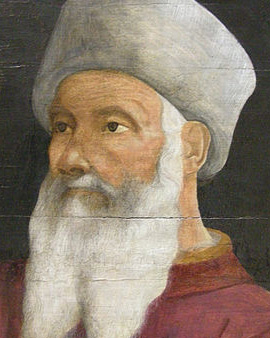


Many of his contemporaries considered the painter Paolo Uccello, who was born in Florence, to be eccentric, some even declared him to be crazy. The artist's civil name was Paolo di Dono, but he became known as Paolo Uccello. He was nicknamed Uccello (bird) because he had depicted countless birds and other animals in his frescoes. Throughout his life Uccello was considered eccentric, melancholic and difficult. No one understood his enthusiasm for spatial perspective, which bordered on obsession. He was influenced by works Donatellos and Tommaso Masaccios. He always endeavoured to depict people and animals in frescoes in three dimensions. The painter often immersed himself for weeks in his mathematical studies of spatial perspective. He was fascinated by geometric forms and their plasticity. The sculptor Donatello, however, believed that Uccello was too preoccupied with the representation of male headgear and wasted his talent on senseless studies. But Uccello continued to devote himself intensively to geometry and mathematics. Even the painter's colouring was new for his time. Uccello immersed cities and landscapes in colors that did not correspond to reality. A painting style that only reappeared centuries later with Expressionism. Uccello's artistic freedom was incomprehensible to his contemporaries. The painter became better known for his vivid-looking battle scenes, which he created from 1440 for the powerful De Medici family. Here too, people and animals were painted three-dimensionally.
Uccello influenced the painting style of the early Renaissance. He was born into a time of beginning upheavals. At the beginning of the 15th century a new artistic era began for Italian painting and sculpture. The Catholic Church, rich dynasties and wealthy merchants brought new sources of income to the artists. Paolo Uccello first learned the art of sculpture and worked in the workshop of Lorenzo Ghiberti. He then went to Venice, where he made mosaics for the church of San Marco. In the following years he created important frescoes in Florence. Interesting is the three-dimensional representation of a monument to an equestrian. The viewer sees the statue diagonally from below. This created the illusion that one sees a sculptural work in front of him. Here the artist's meticulous preoccupation with spatial perspective was particularly evident. At the end of his life, Uccello received fewer and fewer commissions. His apparent eccentricity increasingly isolated him from his fellow men. Uccello had to repeatedly ask for financial support. Despite his modern approach, Paolo Uccello's painting style remained medieval. His preoccupation with perspective became the theme of his life. Today, the painter is considered a pioneer of perspective painting.

Many of his contemporaries considered the painter Paolo Uccello, who was born in Florence, to be eccentric, some even declared him to be crazy. The artist's civil name was Paolo di Dono, but he became known as Paolo Uccello. He was nicknamed Uccello (bird) because he had depicted countless birds and other animals in his frescoes. Throughout his life Uccello was considered eccentric, melancholic and difficult. No one understood his enthusiasm for spatial perspective, which bordered on obsession. He was influenced by works Donatellos and Tommaso Masaccios. He always endeavoured to depict people and animals in frescoes in three dimensions. The painter often immersed himself for weeks in his mathematical studies of spatial perspective. He was fascinated by geometric forms and their plasticity. The sculptor Donatello, however, believed that Uccello was too preoccupied with the representation of male headgear and wasted his talent on senseless studies. But Uccello continued to devote himself intensively to geometry and mathematics. Even the painter's colouring was new for his time. Uccello immersed cities and landscapes in colors that did not correspond to reality. A painting style that only reappeared centuries later with Expressionism. Uccello's artistic freedom was incomprehensible to his contemporaries. The painter became better known for his vivid-looking battle scenes, which he created from 1440 for the powerful De Medici family. Here too, people and animals were painted three-dimensionally.
Uccello influenced the painting style of the early Renaissance. He was born into a time of beginning upheavals. At the beginning of the 15th century a new artistic era began for Italian painting and sculpture. The Catholic Church, rich dynasties and wealthy merchants brought new sources of income to the artists. Paolo Uccello first learned the art of sculpture and worked in the workshop of Lorenzo Ghiberti. He then went to Venice, where he made mosaics for the church of San Marco. In the following years he created important frescoes in Florence. Interesting is the three-dimensional representation of a monument to an equestrian. The viewer sees the statue diagonally from below. This created the illusion that one sees a sculptural work in front of him. Here the artist's meticulous preoccupation with spatial perspective was particularly evident. At the end of his life, Uccello received fewer and fewer commissions. His apparent eccentricity increasingly isolated him from his fellow men. Uccello had to repeatedly ask for financial support. Despite his modern approach, Paolo Uccello's painting style remained medieval. His preoccupation with perspective became the theme of his life. Today, the painter is considered a pioneer of perspective painting.
Page 1 / 2






